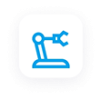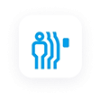Traditionally, industrial applications like excavators, cranes and conveyor belts, and building systems such as lighting, heating, and air conditioning have been manually operated. However, as the needs of building systems, industrial applications, and people are changing along with the change in technologies, manually operating these systems and equipment has become impractical.
To achieve peak performance, they must gauge operating conditions and adjust themselves. It is possible only if these systems are equipped with sensors, which play a crucial role in smart industrial applications and building systems.
In addition, sensors and automatic controls can cut costs as they support energy efficiency, clean energy, and water conservation. For example, a ventilation system with highly efficient motors can save energy. On the other hand, if occupancy sensors are used to adjust the airflow of the ventilation system, even greater energy and cost savings are possible.
There are several factors companies need to consider when they select sensors for their applications. The application type, the product’s variable, and the operating environment are a few among them.
Here we discuss five significant factors businesses must consider when selecting a sensor.
1. Measuring Range
If you have to pick from force, pressure, and position sensors, you must consider the sensor's measurement range. This range should directly correlate with the real measuring range to obtain the correct reading and ensure the maximum lifespan of the sensor.
For example, using slope guidance and two-dimensional (2D) depth, the industrial automated excavator knows the location of the bucket teeth corresponding to the machine’s base. A series of sensors make the smooth operation of the device possible. These include a sensor inside the bucket cylinder, a rotary sensor at the boom-stick link, and a sensor at the boom’s base.
Using these sensing devices, the excavator calculates the stick’s position relative to the boom and the boom’s position relative to the machine's base. By analyzing these geometrical propositions, the machine automatically calculates the location of the teeth corresponding to their base. Ultimately, sensors allow the operator to set the desired slope and depth by sitting inside the automated excavator’s cab.
2. Accuracy and Precision
Precision and accuracy are different, although they are often taken as correlated concepts. Accuracy is the quality of being correct or free from errors, while precision is the ability to identify small changes. For instance, a temperature sensor that displays the average body temperature as 36.999°C possesses higher precision but lower accuracy. The accuracy and precision of a sensor should be appropriate to give the proper indication.
3.Sensor Type and Operating Situations
The typical mistakes in using and selecting sensor applications are failing to pick the correct sensor type for the job and understanding the operating conditions' intricacies. For example, you can use a capacitive proximity sensor for metal detection. But in that case, a finer choice would be an inductive proximity sensor.
In addition, temperature, light, dirt, tremors, or other operating conditions also impact the sensor performance. For instance, if you installed a sensor that can withstand a maximum of 70°C temperature in a place where the temperature can cross 85°C, the sensor might fail prematurely or experience unstable operation. For extreme operating conditions, you should also consider using sensor protection gears to extend the life of sensors.
4. Digital Technology
It is always better to use a sensor that provides a digital output than an analog output in industrial applications. Most companies prefer analog devices as they are cheaper than digital ones. But digital devices are helpful because converting analog signals to digital ones can produce errors.
As a real-world example, Hokuyo’s DMS-GF/HF series optical data transmission devices use digital technology. These sensors enable digital signals to be transmitted quickly and reliably over short distances through a serial interface. Typical applications of these sensors include Automated Guided Vehicles (AGV) and Rail-Guided Vehicles (RGV), where the communication is carried out wirelessly between the vehicle and a fixed docking station.
Digital output also helps you capture sensor data for analytics and gain valuable insights into your equipment's performance.
5. Flexibility
When picking a sensor, consider whether it is flexible enough to meet your changing requirements, such as sensor features that adapt to the changing product. For instance, you can invest in capacitive sensors since they are sensitive to more colors and materials than other types of sensors. In many cases, they are also less expensive than ultrasonic sensors.
Get Top-Quality Sensor Products from Hokuyo
Hokuyo offers a full range of industrial sensor products for the factory, logistics, and process automation industries. Our sensor products include collision avoidance, safety lasers, obstacle detection scanners, optical data transmission devices, and laser rangefinders (LIDAR).
Get in touch with us today to learn how our sensors can help achieve your automation goals.

 Factory Automation
Factory Automation Logistics Automation
Logistics Automation Process Automation
Process Automation Crane Collision Avoidance
Crane Collision Avoidance LiDAR/Obstacle Detection
LiDAR/Obstacle Detection Safety Laser Scanners
Safety Laser Scanners Optical Data Transmission
Optical Data Transmission Hot Metal Detectors
Hot Metal Detectors Laser Distance Sensor
Laser Distance Sensor Blog
Blog Whitepapers
Whitepapers Case Studies
Case Studies Infographics
Infographics